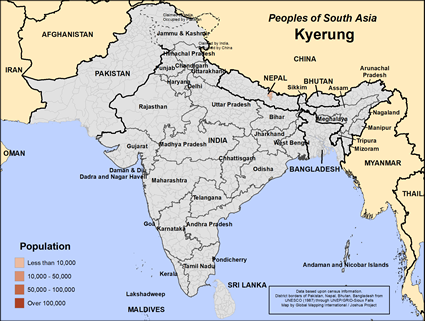Kyerung in Nepal

Photo Source:
Copyrighted © 2026
Operation China, Asia Harvest All rights reserved. Used with permission |

Map Source:
People Group Location: Omid. Other geography / data: GMI. Map Design: Joshua Project
|
| People Name: | Kyerung |
| Country: | Nepal |
| 10/40 Window: | Yes |
| Population: | 3,300 |
| World Population: | 11,600 |
| Primary Language: | Kyerung |
| Primary Religion: | Buddhism |
| Christian Adherents: | 0.00 % |
| Evangelicals: | 0.00 % |
| Scripture: | Portions |
| Ministry Resources: | No |
| Jesus Film: | No |
| Audio Recordings: | Yes |
| People Cluster: | South Asia Buddhist |
| Affinity Bloc: | South Asian Peoples |
| Progress Level: |
|
Introduction / History
The Kyerung are ethnic Tibetans and have been officially counted as part of the Tibetan nationality in China; however, they speak their own language, unintelligible with other Tibetan varieties. The Kyerung make up a significant portion of the 60,000 or more Tibetans in Nepal. The Kyerung are not the same as the Jiarong people of Sichuan Province, although when pronounced in Tibetan the two names sound similar.
The seventh and eighth centuries saw a rapid increase in the Tibetan empire. Tibet's rule extended into Kashmir, China, Turkestan, Sikkim, Bhutan, Nepal, and northern Burma. In 1788 the Tibetans turned to the Chinese for military assistance when they were being besieged by an invading Gurkha army from Nepal. After this, Chinese influence in Tibet increased greatly. The states of Sikkim, Bhutan, and Nepal splintered and became separate political units. By the mid-1800s Manchu power in China was waning; and when the Gurkhas again invaded Tibet in 1856 the Chinese did not help. The Nepalese extracted annual tribute from the Tibetans. By the end of 1959 an estimated 20,000 Tibetans had fled across the border into Nepal and India. Today the number of Tibetans in exile has grown to approximately 200,000. They are scattered in communities in India, Nepal, Bhutan, and Taiwan, in the mountains of Switzerland, in the United States, Norway, Australia, France and England.
What Are Their Lives Like?
The Kyerung are willing to accept other people's beliefs. They have a greeting, Tashiteleg, which means "I recognize the divine qualities in you." Traditionally a man can marry two sisters, or several brothers may share the same wife (although this is now only practiced in remote communities).
What Are Their Beliefs?
The Kyerung, like all Tibetan ethnic groups, zealously follow Tibetan Buddhism.
What Are Their Needs?
There are no known Christian believers among the Kyerung in either Tibet or Nepal. Faithful workers are needed like William E. Simpson, an American missionary to Tibet, who was martyred in 1932. Simpson summarized his life when he wrote, "Are not all the trials, the loneliness, the heartache, the weariness and pain, the cold and fatigue of the long road, the darkness and discouragements, and all the bereavements, temptations and testings, deemed not worthy to be compared with the joy of witnessing to this 'glad tidings of great joy'?
Prayer Points
Ask God to raise up Kyerung who are more desirous to know the truth than to stay on the broad road to death.
Ask God to send loving, committed workers to the Kyerung soon.
Pray the Kyerung would no longer be hidden away from the influence of Christ.